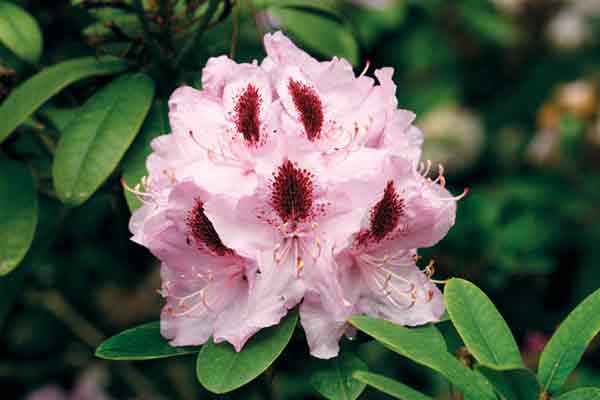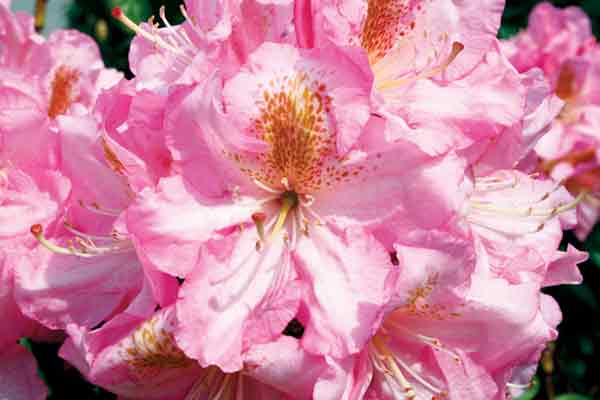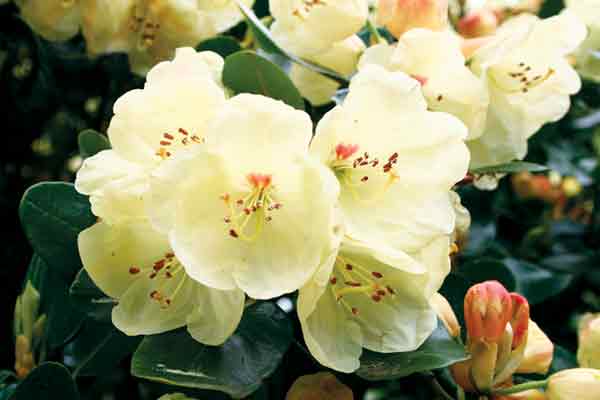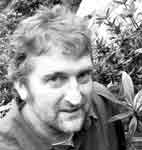JARS v64n1 - Setting up a Rhododendron Gene Bank in Germany
Setting up a Rhododendron Gene Bank in Germany
Caroline Schmidt
Chamber of Agriculture
Lower Saxony, Germany
Dr. Hartwig Schepker
Botanic Garden and Rhododendronpark
Bremen, GermanyGermany has a long tradition of rhododendron cultivation and breeding. The first rhododendrons were introduced more than 200 years ago. The breeding of rhododendrons started shortly after, resulting today in a broad range of German cultivars that includes all major groups of rhododendrons and azaleas. Rhododendrons are now an important horticultural product in Germany that supports a multimillion €-market.
Increasing concerns about the loss of biological diversity has resulted in legal actions aimed not only at the preservation of wild species but also of cultural forms. In Germany, a number of measures have been taken in the past to preserve the diversity of agricultural crop plants. State institutes to date have largely carried out these measures, effected mainly in the form of establishing seed banks. Until now, there has been no national preservation system for ornamental plants. Recently, a unique project was launched to connect plant nurseries, botanical gardens, parks and private gardens throughout Germany with the intention of efficiently managing the preservation of national rhododendron diversity.
The Concept
This three-year project (2008-2010) will create a unique preservation and information network for Rhododendron : the German Rhododendron Gene Bank. Its goals are to identify existing Rhododendron species and cultivars in Germany, to set up a long-term preservation system and to provide appropriate conservation information to breeders and nurseries. Rhododendron collections across Germany that are able to assure long-term preservation of their plants will become affiliated. Rhododendron experts will record their stocks and after verifying the existence of collected species and/or cultivars, store the information in a database. Especially rare cultivars and species will be propagated and distributed between the network members. At the end of the three-year project, breeders will be able to obtain plant material (grafts, cuttings and seeds) from the inventory of the German Rhododendron Gene Bank. This network structure, based on the already existing preservation activities of collectors, will be cost-neutral. The German Rhododendron Gene Bank will serve as an example for future schemes to create gene banks for other ornamental plant species, and is being planned as the first part of an overall German Gene Bank for Horticultural Plants.The project is being coordinated by the Chamber of Agriculture Lower Saxony (LWK), a federal institution with an outstanding background in Rhododendron cultivation and holder of the rhododendron collection in Bad Zwischenahn/Rostrup, one of the largest outdoor collections in Germany. Both the "Stiftung Bremer Rhododendronpark," a foundation that manages the well-known Rhododendron Park of Bremen with its huge collection of hardy and non-hardy rhododendron species and cultivars, and the German Rhododendron Society support the LWK. The German Ministry of Agriculture is funding the project.
The two rhododendron collections in Bad Zwischenahn/Rostrup and Bremen form the backbone of the network. Several other important public (e.g., Botanic Gardens, city parks) and private collections, including some nurseries, add to the network. They are distributed all over Germany and thus include regional variation in collections due to climatic differences. Depending on their ability to ensure a long-term guarantee of their collection, these other partners can act as full or cooperating members of the gene Bank.
Documenting the Work of German Breeders
Alongside England, Scotland, Belgium and the Netherlands, Germany is a hot spot of European rhododendron culture. Over 1500 German cultivars have been bred in the course of the last two hundred years. Thanks to the efforts of hybridizers, rhododendrons have become one of the most important plants cultivated in nurseries, particularly in northern Germany. The German Rhododendron Gene Bank is an inventory and safety system that both documents and vouches the achievements of hybridizers, thereby showing historical developments in garden culture of the genus Rhododendron in Germany.
Bruns, Hachmann, Hobbie, and Seidel are all names well known as experts in Rhododendron hybridization. Seidel's cultivar R. 'Humboldt' (Fig. 1), Hobbie's 'Baden-Baden' and Hachmann's 'Barmstedt' are widely grown not just in Germany but also in North America. However, other German cultivars, such as R. 'Barbarossa', 'Bella', 'Erzherzogin Margarethe' or 'Justizrath Stein' are less well known. The cultivars R. 'Erzherzogin Margarethe' and 'Justizrath Stein', both Seidel varieties, are probably now extinct, although 'Barbarossa' and 'Bella' likely still exist. One of the tasks of the project team is to verify their existence by recording plants in participating collectors and to check the authenticity of their namings. The verification process is an essential prerequisite in assuring that "true" specimens, i.e., those having original genetic material, will be preserved.

|
|---|
Fig. 1: R. 'Humboldt', raised by T.J.R. Seidel, Dresden; introduced in 1906 and is still a popular cultivar in cold climates. Photo by Odo Tschetsch |
Country-wide Stocktaking
In the first year, a stocktaking exercise was carried out across the whole of Germany to start the verification process. Stock lists from the largest and best-known rhododendron collections provided an initial overview of the national and international cultivars and species present in Germany. The result was that the LWK initially listed almost 3800 different cultivars, including ca. 240 American hybrids (Fig. 2), and 550 species, subspecies, varieties and forms. Over the next two years, as many of the cultivars and species as possible are being assessed, and providing that their authenticities are verified, these will be identified for preservation over the long term.

|
|---|
Fig. 2: R. 'Scintillation', an old Dexter-Hybrid (pre-1940) widely planted in German gardens and parks. Photo by Odo Tschetsch |
Special attention is applied to German hybrids that may still be in existence. According to the latest information, 440 of these cultivars are presently only found at one location, meaning that these plants are relatively rare and possibly most vulnerable to loss (Fig. 3). Another 400 German cultivars are at present only known through references in the literature.

|
|---|
Fig. 3: R. 'Goldglockchen', one of the rarest German cultivars, a wardii-hybrid raised by Walter Nagel, Bretten Photo by Odo Tschetsch |
Verification and Propagation of Cultivars and Species
Two specialists working for the LWK began in 2008 to verify stock on sites. They use identification keys, descriptions and pictures from the available literature and comparison plants. They were further assisted by stock owners and national and international rhododendron experts. Over 2000 cultivars and almost 200 species have so far been examined, found to be authentic and have now been listed in the inventory. To ensure that these valuable results are not just stored in the database but also in the collections, the verified individual plants are marked with long-lasting labels. Database Information includes plant descriptions, parentage details, hybridizers, taxonomic classification, and photographs of the verified plants.
Two hundred German cultivars and almost 100 uncommon species were propagated for the German Rhododendron Gene Bank in 2008/09. According to the initial survey, these plants were only growing in one location, increasing the risk that if these plants were lost, a valuable piece of German horticultural history will be lost with them. Thanks to the support of plant owners, who provided grafts and cuttings for propagating the plants, this danger is now minimized, as within a few years, specimens will be growing in other collections comprising the German Rhododendron Gene Bank.
Plant Preservation in Nurseries, Parks and Gardens and Public Relations
The important task of preserving the plants takes place in nurseries, botanical gardens, parks and private gardens (Fig. 4). These institutions can now be networked through the German Rhododendron Gene Bank in a coordinated way. An important future task of the network is to ensure that no rare species or cultivars are lost when members no longer can maintain their collection. The objective is to cultivate at least two plants from every cultivar or wild species, verified for authenticity, in at least two associated gene bank collections.In the future, network members and rhododendron hybridizers will be able to obtain plant material through the network coordinator. A voluntary agreement provides the official framework for the pooling of collections. Members can use the national Gene Bank logo for public relations. Information about rhododendrons cultivated in Germany will be made available on a web-based platform, due to start at the end of 2010.
Progress in this project will be presented on the International Rhododendron Symposium in Bremen in May 2010, part of the 75th Anniversary Conference of the German Rhododendron Society. The conference tour program will include most of the major collections of the Rhododendron Gene Bank Network in northern Germany.

Caroline Schmidt has a degree in horticultural engineering and is the project manager for the Rhododendron Gene Bank, working for the LWK in Bad Zwischenahn/Rostrup.

Dr. Hartwig Schepker is the Scientific Director of the Botanic Garden and Rhododendron-Park Bremen, responsible for a collection of ca. 550 rhododendron species and ca. 3000 cultivars. He is also Secretary of the German Rhododendron Society (DRG) and is currently organizing the International Rhododendron Symposium during the 75th DRG Anniversary Meeting.

